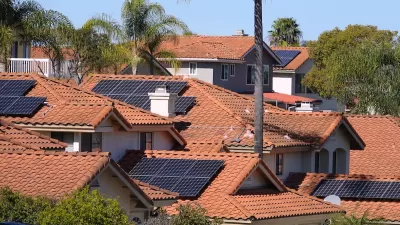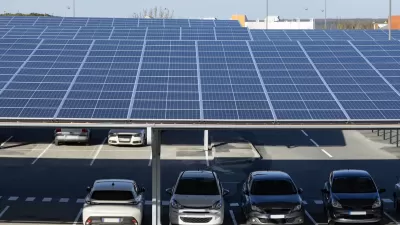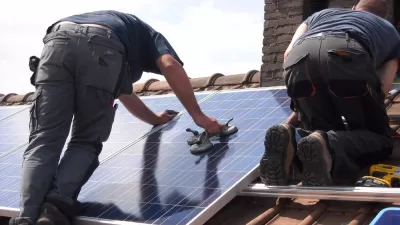Requirements in the NYFD fire code make it costly and difficult to achieve the city’s solar installation goals.

As part of New York City’s plan to reduce emissions by 80 percent by 2050, the city “aims to install 1,000 megawatts of solar technology within the five boroughs by 2030, enough to supply 250,000 homes with electricity.” But so far, “NYC has a 70 megawatt solar gap to close this year alone in order to fulfill its 2030 goal,” reports Zoya Teirstein for Grist, hindered in large part by the city’s building and fire codes.
“[A]s of 2019, the city requires all new buildings and major renovations of existing buildings to include either solar panels or a green roof system. But putting a solar installation on every rooftop in the city isn’t easy — and especially on the rooftops of existing buildings.” At the heart of the conflict is a 2021 revision to the city’s fire code, which calls for “more access pathways around panels and railings around rooftops that have solar on them.” Despite this rule applying to new construction only, the city’s Department of Buildings has denied solar permits for existing buildings on this basis. The rules also designate solar panels as “serviceable equipment” that triggers requirements for walkways and guardrails.
“There’s been no communication with the industry. There’s been no public forum,” says T.R. Ludwig, CEO of Brooklyn Solarworks, citing 13 examples of projects rejected due to the new fire code. While solar companies can apply for variances, the process adds expense and time to the permitting process.
For its part, the city has made some changes to accommodate these concerns. “After conversations with stakeholders,” [Rachel Finkelstein, a senior policy advisor for the NYC Mayor’s Office of Climate and Environmental Justice] said, the Department of Buildings “no longer interprets this section of Code as requiring railings for solar installations. The fire code remains unchanged.”
FULL STORY: NYC wants more rooftop solar. Its fire code is getting in the way.

Alabama: Trump Terminates Settlements for Black Communities Harmed By Raw Sewage
Trump deemed the landmark civil rights agreement “illegal DEI and environmental justice policy.”

Study: Maui’s Plan to Convert Vacation Rentals to Long-Term Housing Could Cause Nearly $1 Billion Economic Loss
The plan would reduce visitor accommodation by 25% resulting in 1,900 jobs lost.

Planetizen Federal Action Tracker
A weekly monitor of how Trump’s orders and actions are impacting planners and planning in America.

This Toronto Suburb Has More Bus Riders Than Columbus, Ohio
Brampton, Ontario used gradual improvements in service to prove that if you build it, they will ride.

Paris Bike Boom Leads to Steep Drop in Air Pollution
The French city’s air quality has improved dramatically in the past 20 years, coinciding with a growth in cycling.

Why Housing Costs More to Build in California Than in Texas
Hard costs like labor and materials combined with ‘soft’ costs such as permitting make building in the San Francisco Bay Area almost three times as costly as in Texas cities.
Urban Design for Planners 1: Software Tools
This six-course series explores essential urban design concepts using open source software and equips planners with the tools they need to participate fully in the urban design process.
Planning for Universal Design
Learn the tools for implementing Universal Design in planning regulations.
Smith Gee Studio
Alamo Area Metropolitan Planning Organization
City of Santa Clarita
Institute for Housing and Urban Development Studies (IHS)
City of Grandview
Harvard GSD Executive Education
Toledo-Lucas County Plan Commissions
Salt Lake City
NYU Wagner Graduate School of Public Service





























